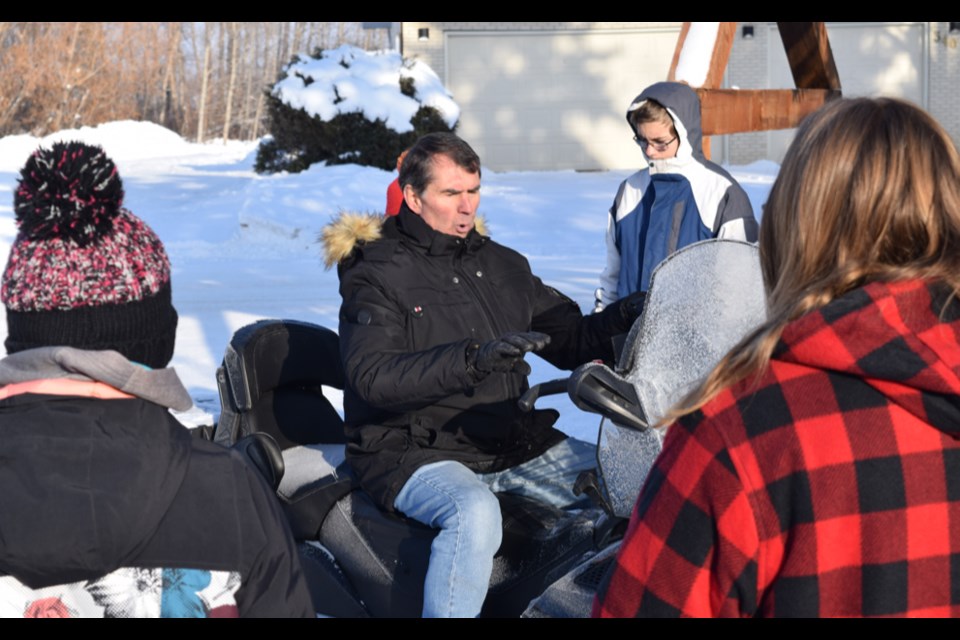CANORA - With a total of 18 students who signed up, Trakkers Snowmobile Club of Canora hosted a snowmobile safety course at the Canora Golf and Country Club on Dec. 10.
In addition to Canora, participants were from a variety of area communities, including: Invermay, Sturgis, Preeceville, Kamsack, Veregin and Yorkton. The course is required for everyone born after Jan. 1, 1989 who is 12 years of age and older if they want to travel on local snowmobile routes.
Instructor Jerry Jemieff of the Saskatchewan Snowmobile Association, who has over 30 years of snowmobiling experience, explained that the main objective of the course “is to promote safe riding, especially among people just starting up, in the 12 to 21 age group.”
Jemieff explained that common sense plays a big role in safe snowmobiling.
“You probably wouldn’t drive your vehicle if it was minus 30 degrees with a minus 45 wind chill and zero visibility in a blizzard, and the same goes for snowmobiling.”
When asked about the biggest mistakes made by snowmobile riders, Jemieff quickly replied, “speed, alcohol and drugs.”
He reminded that class that RCMP officers have their own snowmobiles and patrol snowmobile routes regularly. Financial penalties for not following the rules range from $80 for riding an unregistered snowmobile to $130 for operating a snowmobile without a license.
“Approximately 80 per cent of the time it’s not the riders that pay the fines, it’s their parents.”
During the course, students learned about the general design of snowmobiles, including instruments and controls.
On an actual snowmobile, Jemieff took them through a pre-start check including: making sure the throttle doesn’t stick, checking the fuel/oil levels, making sure the brake lever operates properly, checking that the steering works properly, checking the drive belt and track for wear, and making sure the lighting system works, including the brake lights.
After the snowmobile starts, it’s important to check if the emergency stop switch is working. The rider should also rotate the track to clear it of bits of ice, frozen snow, or anything else that could impede it from working properly.
Of course, safe snowmobile operation was emphasized.
Students learned that snowmobile riding is permitted:
- on Crown land, including highway rights-of-way and designated park trails, except on roads and in areas prohibited by signs;
- on privately-owned land with written permission of the owner-tenant;
- on privately-owned land outside the limits of cities, towns, villages and hamlets not posted with signs prohibiting trespassing or snowmobiling; and
- on Saskatchewan Snowmobile Association designated trails.
Snowmobilers must obey all traffic rules including the snowmobile speed limit of 80 km/hr, or slower, if posted.
The class included teaching the proper hand signals for: stop, right turn, left turn, last sled in line, stop ahead, oncoming sleds, sleds following, and slowing.
Students learned the trail signs they need to know for riding on snowmobile trails as well as public streets and highways.
Class members were taught about taking safety precautions during special snowmobiling situations including: night riding, ditch riding, blizzards and whiteouts, flat light conditions, and frozen lakes, rivers and slush.
When operating with a passenger, it’s important to:
- carry only one passenger;
- make sure the passenger is wearing a certified helmet, which is required by law;
- make sure the passenger is properly dressed- warm, windproof clothing, no loose clothing or scarves that could get caught in machinery;
- use moderate speed; and
- warn the passenger of low-lying branches, bumps or rough ground; and check the passenger regularly for frostbite. (Passenger has less protection, visibility and support than the driver.)
Jemieff reminds snowmobilers that they have the option to take the snowmobile safety course in person or online. More information is available at sasksnow.com. For anyone looking to take the course in person, Springside will be hosting a class on Jan. 28.




